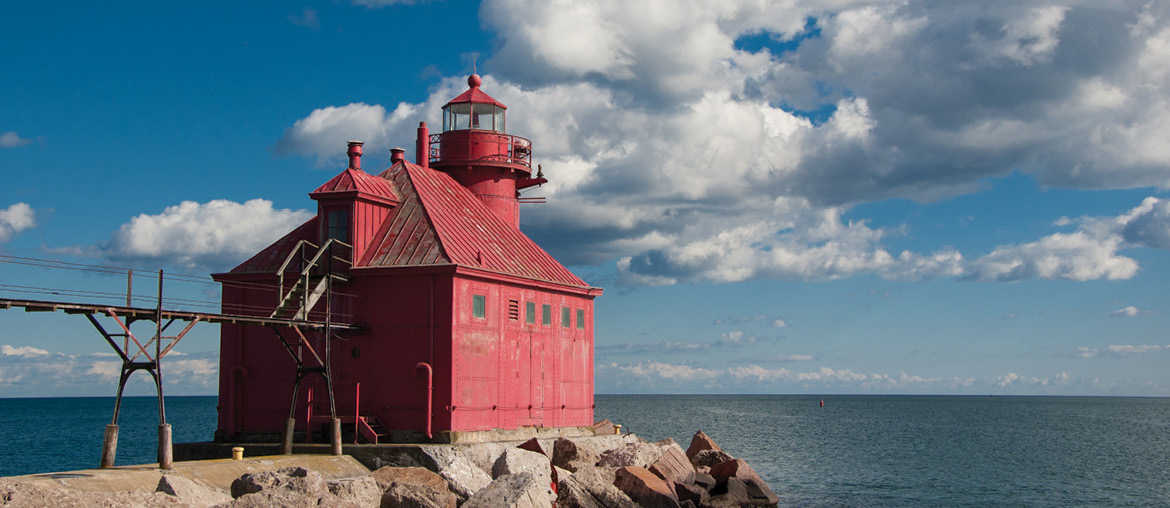The walk begins on 300 feet of rocky causeway, then a trail of mulch that ends at the 90-foot-tall Cana Island Lighthouse, north of Baileys Harbor. The view from the top of a 97-step, twisted staircase stretches many miles on a clear day.
Appearances? Deceiving. An outing to climb the tower and inspect the artifacts of this popular Door County tower seems idyllic in modern times, but the 1870 brick beacon harbors a dark and tempestuous history.
Lake Michigan touches the 8.7-acre island, but not always gently. Storms with gale-force winds flooded the isolated light keeper’s home several times, until surrounding swampland was stabilized in 1890.
Maritime experts say the Great Lakes can be more dangerous to navigate than oceans. Freshwater is lighter than salt water, so the slap of waves is faster and less predictable. Add the challenge of maneuvering narrow straits and skirting around small islands.
At least 2,000 vessels have met their demise while on Lake Michigan, and no other Great Lake contains more lighthouses.
ISOLATED ROCK ISLAND
Of the 11 navigational devices noted in Door County tourism brochures, the most remote yet accessible is on Rock Island, whose state park is the least-visited in Wisconsin, but not because of a lack of charm.
It takes two ferry rides (30 minutes, a short drive, then 15 minutes) to reach Rock Island and the 1836 Pottawatomie Lighthouse, the oldest of all in Wisconsin. Cars and bicycles are not allowed. Campsites are rustic.
From Memorial Day weekend to Columbus Day, volunteer light keepers donate one week of time to care for Pottawatomie Lighthouse, which has no electricity or indoor plumbing. These lighthouse lovers also lead tours through the structure, located on a limestone bluff and more than one mile from where the ferry lands.
Also on the 900-acre island are 10 miles of hiking trails, a pristine beach and an historic stone boathouse whose enormous Viking Hall houses ornate Icelandic furniture and one of the widest and tallest fireplaces around. The boathouse was part of a wealthy Chicago businessman’s long-ago summer estate.
DOOM AT DEATH’S DOOR
The six nautical miles that separate Washington Island and the county’s mainland are known as Porte des Mortes (Port of Death) or Death’s Door because raging currents and violent wind shifts have a reputation of crashing ships into rocky shorelines.
In 1872 alone, at least 100 vessels unsuccessfully tried to get through this passageway.
Only foundation stones remain from the area’s Plum Island range lights, which stayed in place only 10 years before being relocated to rocky Pilot Island in 1858. Both islands also were home to lifesaving stations and are closed to the public, but nonprofit groups aim to restore the deteriorated structures.
Although active aids to navigation remain elsewhere in Door County, now computer programs, radio commands and GPS devices assist in paving the way for freighters and yachts.
A HARD LIFE FOR LIGHT KEEPERS
So the lighthouses that remain are quaint structures with compelling histories of strife and challenge for the people who operated them. Consider the lives of William and Julia Duclon, who operated Eagle Bluff Lighthouse for 35 years. They raised seven sons in the secluded structure, and provisions were delivered by boat only once a year.
LIGHTHOUSE IMMERSIONS
Tour lighthouse sites with a guide and by boat, foot, trolley or Segway during Door County’s annual Lighthouse Festival, June 13-15. The event kicks off with a gathering of lighthouse keepers’ relatives, who share artifacts and stories from when these maritime sites were staffed.
Tour choices vary in length, hiking time and theme (such as ghosts, nature, history, shipwrecks). Tour vessels include a fireboat, schooner and motorized cruising boats. Some events sell out weeks in advance because sites visited are not normally accessible to the public.
Door County Maritime Museum staff organizes this popular event. www.dcmm.org, (920) 743-5958
Door County Trolley, from June to mid October, offers narrated lighthouse tours that last five hours. www.doorcountytrolley.com, (866) 604-5573
Ask for the Lighthouse Map of Door County before exploring lighthouse sites on your own. The brochure notes lighthouse locations and whether/ when sites are open to the public. www.doorcounty.com, (800) 527-3529
OPEN FOR VISITS
Some Door County lighthouse sites are not open to the public because they are active Coast Guard facilities, privately owned or in inaccessible locations. Here are exceptions.
BAILEYS HARBOR RANGE LIGHTS 8270 Hwy. 57, Baileys Harbor – grounds are open, but not structures.
CANA ISLAND LIGHTHOUSE 8800 E. Cana Island Rd., Baileys Harbor – grounds are open; lighthouse tours daily, May to October.
CANAL STATION PIERHEAD LIGHTHOUSE 2501 Canal Rd., Sturgeon Bay – only lower-level pier is accessible.
CHAMBERS ISLAND LIGHTHOUSE Northwest corner – open Memorial Day to Labor Day, when caretaker is available; boat transportation required.
EAGLE BLUFF LIGHTHOUSE, Shore Road, Peninsula State Park – museum open and guided tours, May to October.
POTTAWATOMIE LIGHTHOUSE North end, Rock Island State Park – guided tours, May to October.
The family survived by fishing, hunting, gardening and raising cattle and chickens. Today the lighthouse is inside Peninsula State Park, and its museum contains furnishings from the Duclon era.
Harder to visit is Chamber Island Lighthouse, also near Fish Creek, because it requires a boat ride from the mainland and is only open when the caretaker is available.
On the Lake Michigan side of the peninsula are the Baileys Harbor Range Lights. One looks like a church because of its steepleish top; the other building is octagonal and shorter. Both are visible from hiking trails at The Ridges Sanctuary and linked by a long boardwalk.
CHANGES IN TECHNOLOGY
Before lighthouses were erected in the 1800s, captains had little more than gut instinct to safely move tons of cargo – lumber, iron ore, hopeful immigrants – into and out of the busy port of Green Bay, 70 miles from Door County’s tip.
Darkness, fog and blizzards would severely complicate the pathway of steamboats and schooners. The first lighthouse lamps were lit with mineral oil, lard oil or kerosene before batteries, solar energy or automation were possible.
Foghorns, whistles and sirens signaled danger and identified location. At Sherwood Point Light, north of Potawatomi State Park and near Sturgeon Bay, the light keeper would ring a 600-pound bell several times a minute when fog was heavy. The 1883 structure, automated in 1983, was the last on the Great Lakes to keep a full-time staff.
At the opposite end of the seven-mile-long Sturgeon Bay Ship Canal – dredged to cut through Door County and significantly save navigational time – are the tall, white Canal Light and stocky, red North Pierhead Light.
Also on the canal’s shore is the Door County Maritime Museum, whose exhibits on lighthouse stories and artifacts cater from nautical scholars to the mildly curious.
This article originally appeared in the 2014 spring/summer issue of Experience Wisconsin magazine. The contents of this article were checked for accuracy when it was published; however, it’s possible some of the information has changed. We recommend you call first if you have specific questions for the destinations, attractions or restaurants mentioned in this article.
No portion of this article or magazine may be reproduced without prior written permission by the publisher.






Comments are closed.